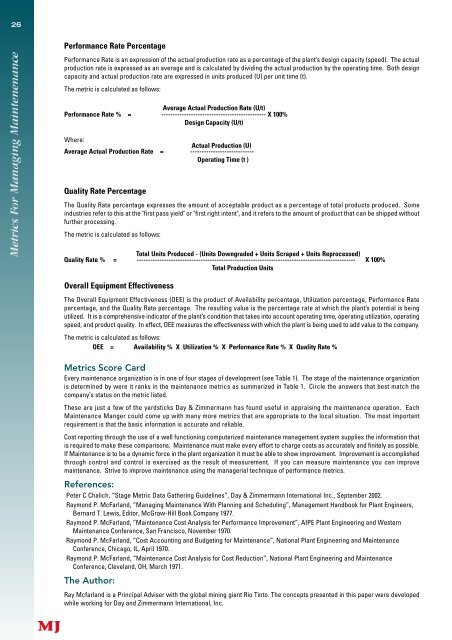October - Library - Central Queensland University
October - Library - Central Queensland University
October - Library - Central Queensland University
Create successful ePaper yourself
Turn your PDF publications into a flip-book with our unique Google optimized e-Paper software.
26<br />
Performance Rate Percentage<br />
P e rf o rmance Rate is an expression of the actual production rate as a percentage of the plant’s design capacity (speed). The actual<br />
production rate is expressed as an average and is calculated by dividing the actual production by the operating time. Both design<br />
capacity and actual production rate are expressed in units produced (U) per unit time (t).<br />
The metric is calculated as follows:<br />
Average Actual Production Rate (U/t)<br />
Performance Rate % = ---------------------------------------------- X 100%<br />
Design Capacity (U/t)<br />
Where:<br />
Actual Production (U)<br />
Average Actual Production Rate = ----------------------------<br />
Operating Time (t )<br />
Quality Rate Percentage<br />
The Quality Rate percentage expresses the amount of acceptable product as a percentage of total products produced. Some<br />
industries refer to this at the "first pass yield" or "first right intent", and it refers to the amount of product that can be shipped without<br />
further processing.<br />
The metric is calculated as follows:<br />
Total Units Produced - (Units Downgraded + Units Scraped + Units Reprocessed)<br />
Quality Rate % = ------------------------------------------------------------------------------------------------ X 100%<br />
Total Production Units<br />
Overall Equipment Effectiveness<br />
The Overall Equipment Effectiveness (OEE) is the product of Availability percentage, Utilization percentage, Perf o rmance Rate<br />
p e rcentage, and the Quality Rate percentage. The resulting value is the percentage rate at which the plant’s potential is being<br />
utilized. It is a comprehensive indicator of the plant’s condition that takes into account operating time, operating utilization, operating<br />
speed, and product quality. In effect, OEE measures the effectiveness with which the plant is being used to add value to the company.<br />
The metric is calculated as follows:<br />
OEE = Availability % X Utilization % X Performance Rate % X Quality Rate %<br />
Metrics Score Card<br />
Every maintenance organization is in one of four stages of development (see Table 1). The stage of the maintenance organization<br />
is determined by were it ranks in the maintenance metrics as summarized in Table 1. Circle the answers that best match the<br />
company’s status on the metric listed.<br />
These are just a few of the yardsticks Day & Zimmermann has found useful in appraising the maintenance operation. Each<br />
Maintenance Manger could come up with many more metrics that are appropriate to the local situation. The most import a n t<br />
requirement is that the basic information is accurate and reliable.<br />
Cost reporting through the use of a well functioning computerized maintenance management system supplies the information that<br />
is re q u i red to make these comparisons. Maintenance must make every eff o rt to charge costs as accurately and finitely as possible.<br />
If Maintenance is to be a dynamic force in the plant organization it must be able to show improvement. Improvement is accomplished<br />
t h rough control and control is exercised as the result of measurement. If you can measure maintenance you can impro v e<br />
maintenance. Strive to improve maintenance using the managerial technique of performance metrics.<br />
References:<br />
Peter C Chalich, “Stage Metric Data Gathering Guidelines”, Day & Zimmermann International Inc., September 2002.<br />
Raymond P. McFarland, “Managing Maintenance With Planning and Scheduling”, Management Handbook for Plant Engineers,<br />
Bernard T. Lewis, Editor, McGraw-Hill Book Company 1977.<br />
Raymond P. McFarland, “Maintenance Cost Analysis for Performance Improvement”, AIPE Plant Engineering and Western<br />
Maintenance Conference, San Francisco, November 1970.<br />
Raymond P. McFarland, “Cost Accounting and Budgeting for Maintenance”, National Plant Engineering and Maintenance<br />
Conference, Chicago, IL, April 1970.<br />
Raymond P. McFarland, “Maintenance Cost Analysis for Cost Reduction”, National Plant Engineering and Maintenance<br />
Conference, Cleveland, OH, March 1971.<br />
The Author:<br />
Ray Mcfarland is a Principal Adviser with the global mining giant Rio Tinto. The concepts presented in this paper were developed<br />
while working for Day and Zimmermann International, Inc.
















